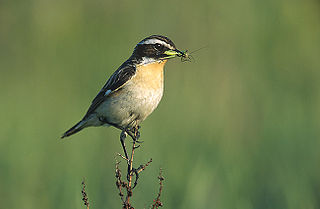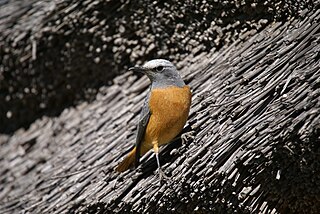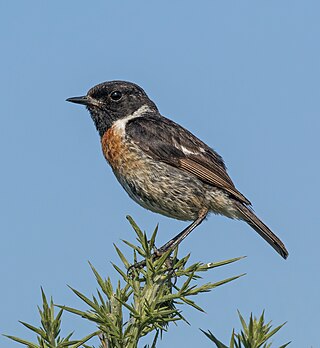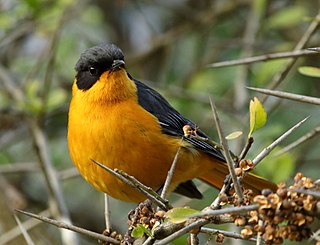
Chats are a group of small Old World insectivorous birds formerly classified as members of the thrush family (Turdidae), but following genetic DNA analysis, are now considered to belong to the Old World flycatcher family (Muscicapidae).

The Old World flycatchers are a large family, the Muscicapidae, of small passerine birds restricted to the Old World, with the exception of several vagrants and two species, bluethroat and northern wheatear, found also in North America. These are mainly small arboreal insectivores, many of which, as the name implies, take their prey on the wing. The family is relatively large and includes 357 species, which are divided into 54 genera.

The rock thrushes, Monticola, are a genus of chats, medium-sized mostly insectivorous or omnivorous songbirds. All are Old World birds, and most are associated with mountainous regions.

The akalats are medium-sized insectivorous birds in the genus Sheppardia. They were formerly placed in the thrush family, Turdidae, but are more often now treated as part of the Old World flycatcher family, Muscicapidae.

Cossypha are small insectivorous birds, with most species called robin-chats. They were formerly in the thrush family Turdidae, but are now more often treated as part of the Old World flycatcher Muscicapidae.

The scrub robins or bush chats are medium-sized insectivorous birds in the genus Cercotrichas. They were formerly considered to be in the thrush family, (Turdidae), but are more often now treated as part of the Old World flycatcher family, (Muscicapidae). They are not closely related to the Australian scrub-robins, genus Drymodes in the family Petroicidae.

Saxicola, the stonechats or chats, is a genus of 15 species of small passerine birds restricted to the Old World. They are insectivores occurring in open scrubland and grassland with scattered small shrubs.

Brachypteryx is a genus of passerine birds in the family Muscicapidae containing ten species known as shortwings, that occurs in southeast Asia.

Melaenornis is a genus of small passerine birds in the large family Muscicapidae commonly known as the Old World flycatchers. They are restricted to sub-Saharan Africa.

The Cape robin-chat is a small passerine bird of the Old World flycatcher family Muscicapidae. It has a disjunct range from South Sudan to South Africa.

The Karoo chat is a small passerine bird of the Old World flycatcher family Muscicapidae. It is a common resident breeder in southwesternmost Angola, western Namibia and western South Africa. Its habitat is Karoo and desert scrub in the south, extending to the escarpment zone in the north.

The chorister robin-chat is a species of bird in the Old World flycatcher family Muscicapidae. It is found in South Africa and Eswatini. Its distribution stretches from the southern Western Cape through the Eastern Cape, KwaZulu-Natal, and Mpumalanga to northern Limpopo. Its natural habitat is evergreen forests, especially in the mist belt region.
The mountain robin-chat is a species of bird in the Old World flycatcher family Muscicapidae.

The red-capped robin-chat or Natal robin is a species of passerine bird belonging to the family Muscicapidae. This species is found in Southern and Eastern Africa.

The white-bellied robin-chat is a species of bird in the Old World flycatcher family Muscicapidae. It is found across the Western High Plateau, Bioko and the Albertine Rift montane forests. Its natural habitats are subtropical or tropical moist lowland forest and subtropical or tropical moist montane forest.

Fraseria is a genus of passerine birds in the Old World flycatcher family Muscicapidae that are found in Sub-Saharan Africa.
Tessmann's flycatcher is a species of bird in the family Muscicapidae. It is sparsely distributed across the African tropical rainforest from Sierra Leone to the Democratic Republic of the Congo. Its natural habitat is subtropical or tropical moist shrubland.

The Herero chat is a species of passerine bird belonging to the family Muscicapidae, the chats and Old World flycatchers. It is the only species in the monospecific genus Namibornis and it has a restricted range in southwestern Africa.

Niltava is a genus of passerine birds in the Old World flycatcher family Muscicapidae. They are found in found in South and Southeast Asia as well as in China. The seven species in the genus are sexually dimorphic. The males have blue upperparts and all except the large niltava have orange-rufous underparts. The females are less brightly coloured and have brown upperparts and buffish underparts.

Dessonornis is a genus of birds in the Old World flycatcher family Muscicapidae that are found in Sub-Saharan Africa.


















